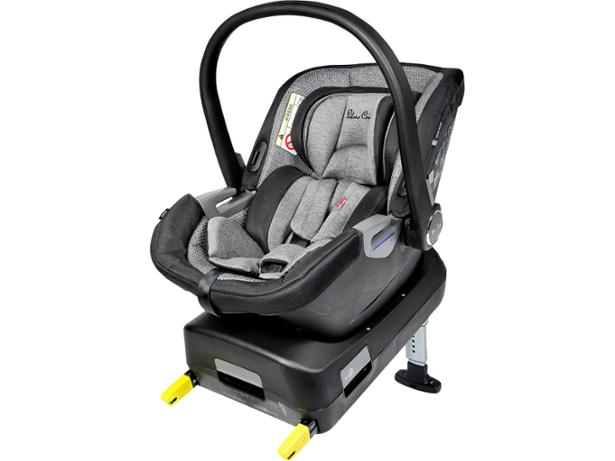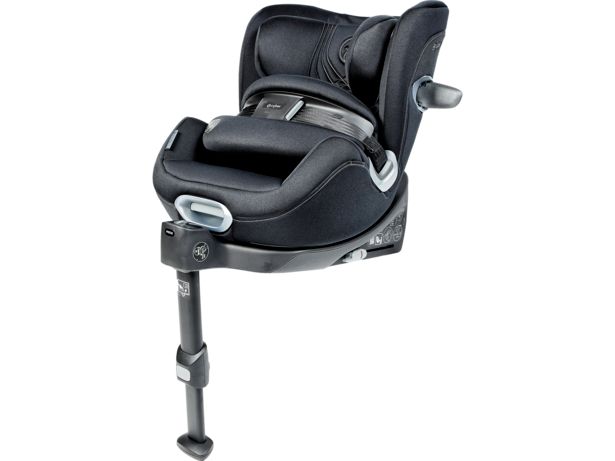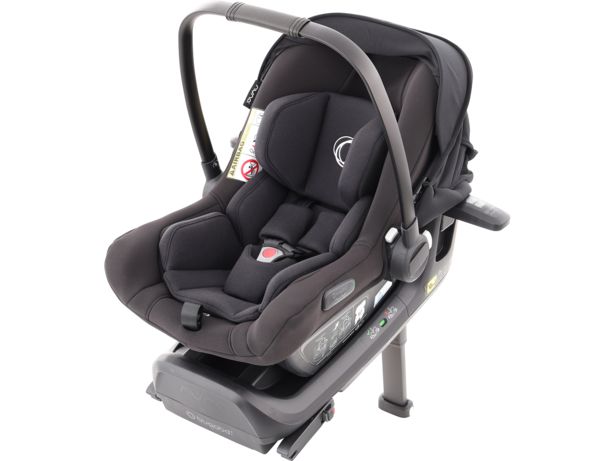By clicking a retailer link you consent to third-party cookies that track your onward journey. If you make a purchase, Which? will receive an affiliate commission, which supports our mission to be the UK's consumer champion.
How to fit a baby or child car seat

In this article
- Download our 10 essential child car seat checks
- Is there anyone that can check if my car seat is fitted correctly?
- Fitting problems and signs your car seat is fitted wrongly
- Is it safe to use a car seat without the base?
- Is a car seat safer behind the driver or the passenger?
- Is it safe to have three car seats in a row?
- Video: how to fit a rearward-facing baby car seat
- Video: how to fit a high-back booster seat
Now that you’ve bought the right car seat for your child and it's one you know will fit into your car, it’s important that it’s fitted properly.
We recommend you get your car seat fitted either by a trained professional working for the retailer you bought it from, or by a trained fitter. Otherwise, you’ll need to install the car seat correctly yourself.
In February 2024 we quizzed 2,735 parents with a child aged up to five years – those that owned a car seat were asked how they learned how to safely fit it.
The results showed that 34% used an instruction manual, while 13% got a retailer to fit it. More than a quarter (28%) used a video tutorial to guide them while 12% enlisted the help of a relative or friend.
A worrying 7% of parents worked out how to fit their car seat without instructions - we wouldn't recommend this.
Go to the best baby and child car seats to see which came out top in our tough crash tests
Download our 10 essential child car seat checks
Checking your baby or child's car seat regularly will help keep them safe.
Download our free checklist and keep it handy so you can regularly check your car seat, or take it with you when you go to buy a car seat.
pdf (6.69 MB)
There is a file available for download. (pdf — 6.69 MB). This file is available for download at .
1. Is the seatbelt or harness secure and untwisted?
If your child car seat is secured with a seatbelt, this must be tight so the seat doesn't move. To test this, try pushing down on the seat where your baby's head would be if the seat is rearward facing, and pulling on the harness if it's forward facing – you shouldn't be able to move the seat. The seatbelt must not be twisted anywhere around the seat.
2. If the seat is rearward facing, is the handlebar in the correct position as shown in the instructions?
For some rearward-facing child car seats, the handlebar may need to be in a certain position, usually upright or fully back, as it can offer added 360-degree protection if your vehicle turns over in a crash. Look at your child car seat's instruction manual to find out where yours should be.
3. Is the child car seat sitting squarely and is the headrest in the correct position?
The majority of the base of the child car seat should be flat on the seat, sitting squarely and evenly. It shouldn't be riding up, which can sometimes happen if the seatbelt is too short.
For most child car seats the headrest should be removed so it doesn't touch the seat at all. However, some child car seats need the headrest to be attached – check the instructions to find out what's needed for your specific seat.
4. Is the seatbelt following the correct red or blue route guides?
Not having the seatbelt securely fitted into the blue or red route guides will weaken the seat's protection. Check it’s right: red guides for forward-facing seats, blue guides for rearward-facing seats. Seats that are approved to R129 i-Size regulations tend to have green belt guides.
5. Is the metal end of the seatbelt in the right place?
The metal end of the seatbelt (the bit that goes into the buckle) must not be bending around the child car seat in order to fix it into the buckle. This could cause it to fail in a crash. Only the seatbelt should be in contact with the frame of the child car seat.
You don't tend to experience this with newer cars, as the buckle is recessed into the adult seats so the metal end of the seatbelt doesn't come into contact with the child car seat.
6. For Isofix seats, do the visual indicators show it is fitted correctly?
Visual indicators should show you that the seat is correctly clipped into the car – for example, sections may turn from red to green. Check the instructions to see what this should look like for your seat.

7. Is your Isofix support leg securely on the floor and is the top tether firmly attached?
If you have an Isofix car seat, you will have either a support leg, a top tether or both. With the support leg, you must ensure it sits firmly on the floor, isn't lifting the seat up and isn't resting on underfloor storage, as this could make it less effective in a crash.
The top tether must go over the back of the seat and clip into the dedicated mounting point – be careful not to attach it to luggage hooks.
For more details, consult our expert guide: What are isofix baby car seats?
8. Have you removed any thick clothes?
Thick clothes, such as bulky winter jackets, will make the harness or impact shield less effective as it's harder to get either tightly fitted to your child, so take off any thick items they're wearing before putting your child in the seat.

9. Are the shoulder pads level with your child’s shoulders and is the harness secure?
The shoulder pads of the harness should be as level with your child's shoulders as possible. If they're in a rearward-facing child car seat, the shoulder pads should be dropping down no more than an inch, and in a forward-facing seat, raising no more than an inch.
The harness shouldn't be too tight or loose. Make sure you can get two fingers between the child’s collar bone and the harness, and that there is no slackness.
10. For older children, is the seatbelt across their shoulder and hips?
If you have an older child strapped into a car seat with the seatbelt, this should sit on their shoulder. It shouldn't cut into their neck or sit lower down on their arm. The lap part of the seatbelt should sit across their hips, not their tummy.
Ways to keep your family living costs down, and kids of all ages happy. Get our Family newsletter – it's free monthly
Is there anyone that can check if my car seat is fitted correctly?
Some retailers, such as Halfords, Mamas & Papas or John Lewis, offer a child car seat fitting service, where if you buy the seat in their shop, a qualified car seat fitter will come out to your car with you after you've bought the seat and make sure it's installed correctly.
This may not be available at all stores so it's worth checking beforehand, and it's obviously not an option if you've bought the car seat from a purely online retailer.
In this case, you'll need to fit the seat yourself, and we'd recommend you read the instructions thoroughly and watch any installation videos provided by the manufacturer before starting.
If possible, attend a child car seat fitting event. This is where car seat fitting experts will check your seat is installed correctly.
These are carried out across the country and you can find out where and when your next event is by visiting childseatsafety.co.uk or goodeggcarsafety.com.
Fitting problems and signs your car seat is fitted wrongly
Harness issues
A child car seat harness should fit snugly across your child's body, with space for two fingers between the harness and the child.
In our images, there's too much space between the child and the harness, leaving room for the shoulders to slip out and the child would be thrown too far forwards in a collision.

Twisted adult seatbelt
If a seatbelt is twisted, it won't react as it should in a collision. As you can see from our images below, sometimes seatbelt twisting can be obvious or subtle.
When fitting your car seat, make sure that the seatbelts run smoothly and securely through any fittings. The same applies if the car seat uses the seatbelt to hold your child in place.

Incorrect adult seatbelt positioning
When a child is seated in a booster car seat, the adult seatbelt should come across the child's shoulder and lap.
In the pictures below the seatbelt is under the armpit. In a car crash the seatbelt would fail to reduce movement in the upper body, which could lead to injury.

Likewise, in the pictures below, the seatbelt should come across the child's shoulder and chest, but the seatbelt cuts across the neck. You should also avoid it restraining the child over the upper arm.

Check if the seatbelt comes across the tummy. With a suitable child car seat, the adult seatbelt should come across the child's lap. If the seatbelt sits across the child's tummy, as in the images below, the seatbelt could crush the soft internal organs, including the stomach and liver, and cause serious internal injuries.

Adult seatbelt is too slack
A child could be thrown out of the seat in a crash if the adult seatbelt isn’t tightly fitted so that it securely keeps the child and car seat in place.
In the first image below, the seatbelt being slack across the lap could mean too much force is applied to the chest by the seat belt, crushing the lungs. Or the child car seat could move in a collision.
In the second image, the belt is so slack across the child's shoulder that it wouldn't stop her moving forward during a crash.
Always make sure the seatbelt is properly clicked into its buckle and that harnesses are secured tightly.

Buckle crunch
Positioning the car’s seatbelt buckle hard up against the child seat frame can cause the buckle to fail under crash conditions.
Only the seatbelt webbing should be in contact with the frame of the child car seat. If the buckle of the adult belt lies across the frame of the child seat, pressure on the buckle (in an accident, or even under sharp braking) could cause the buckle to fail.
If it fails the buckle is likely to open, allowing your baby or child to be projected out of the seat, completely unrestrained.

Unstable car seat positioning
If fitted properly, your car seat should have minimal forward or sideways movement. When you open the buckle of the adult belt, the car seat should spring upward slightly.
If your rear seats slope down from front to back and towards the middle, it might mean the car seat doesn’t sit flush with the vehicle seat. Don’t place anything beneath the child car seat to adjust this (a blanket, for example), but contact your car and car seat manufacturer for advice.
Isofix problems
Always check that your seat is properly connected to the Isofix points and pushed in as far as it can go. Watch online videos and consult the instruction manual and manufacturer for advice on how to do this, or get your car seat checked by a professional fitter.
For more expert safety advice, see our comprehensive guide to car seat accessories
Is it safe to use a car seat without the base?
Not all car seats can be used without an Isofix base, but some allow a belted installation.
Check the instruction manual or our car seat reviews to what installation methods are possible for your car seat.
You cannot attach a car seat without the base if the instructions prohibit this.
Is a car seat safer behind the driver or the passenger?
The safest place for your child is in the back of the car, so do always try to fit your car seat in the back.
The back middle seat is generally the safest and can be used, but only if the seat has a three-point seat belt.
Make sure to disable any active airbags in front of your child as they can cause serious injury, especially if your child is rearward-facing.
If you want to put them in the front of the car, make sure the passenger seat is pushed as far back away from the dashboard as possible, disable the airbag for that seat and fit the child car seat securely.
Is it safe to have three car seats in a row?
In this instance the size of the car seats and the space in the rear of the car may be an issue.
If you have lap belt seat belt for the middle rear seat, rather than a standard three-point seat belt, it can't be used to attach a car seat. In this instance you would only be able to fit two car seats in the rear.
Video: how to fit a rearward-facing baby car seat
Video: how to fit a high-back booster seat
If you still need help choosing, or are looking to buy a new car seat, read our baby and child car seats reviews.
Video: How to put a newborn baby in a car seat
Newborns can sometimes feel as tiny and delicate as a precious vase, and that can mean parents may feel unsure about how tightly to strap them into their car seat.
The reality is that young babies need to be positioned and strapped in so there’s no risk of straps slipping and they’re completely snug and secure.
Watch our video below for a step-by-step guide to putting your baby safely in an infant car seat.
Why does a baby need the right size of car seat?
When babies are born, their bones and muscles still have a lot of growing and strengthening to do. They're particularly vulnerable to injuries caused by impact and uncontrolled movements of their head.
The head, neck and spine
The head is large and heavy in comparison with the rest of a baby's body, accounting for about a quarter of its total length and about a third of the weight.
The skull bones are separated by membrane-filled spaces that slowly grow together. They're not fully fused until 18 to 24 months after birth.
This means that a baby's skull is very flexible; relatively low impacts can result in significant deformation of the skull and brain. The smaller the child, the lower the impact needed for injury.
The neck muscles are weak and unable to lift or control the movement of the head.
The chest and pelvis
A baby’s ribcage is very flexible, too. An impact to the chest can result in the chest wall squashing the heart and lungs.
The ribcage isn't well developed and can't protect some of the abdominal organs, and the bones in the infant pelvis aren't fused together strongly like an adult's.
These things mean an infant's chest and pelvis can’t absorb strain from a restraint without the risk of injury to the internal organs, which is where a good baby car seat comes into its own.
A well-designed seat will cushion your baby in the event of a crash and help to divert the crash force away from your baby's body.
Find out how we test baby and child car seats to see which models will protect your child during a crash



